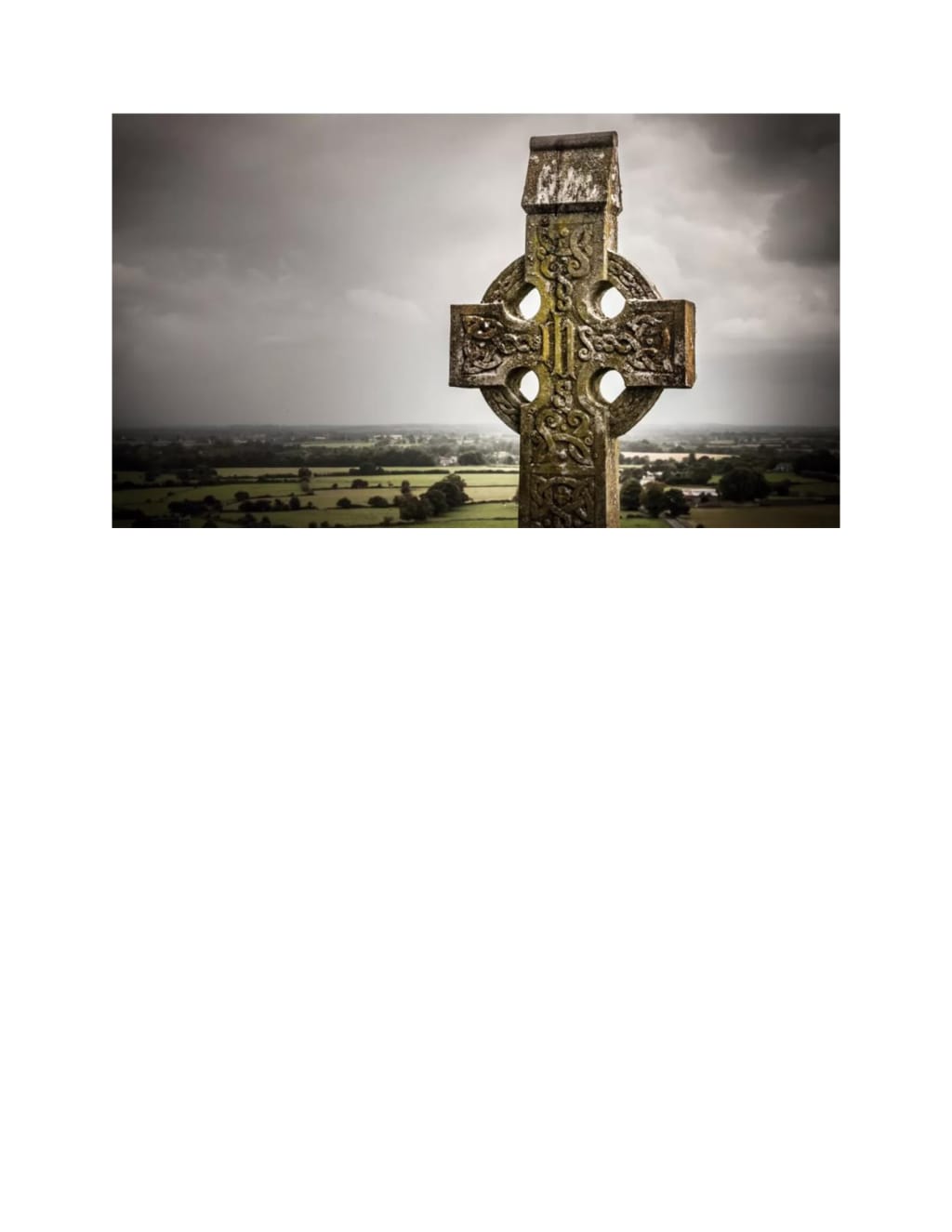CELTIC IDENTITY IN BRITISH CULTURE & ART
Celtic Identity

AYSU BOZ
CELTIC IDENTITY IN BRITISH CULTURE & ART
The British Isles have a diverse history that has been influenced and shaped by various cultures and identities throughout history. Celtic culture has had a significant impact on English culture and art. The Celts are a people who arrived in the British Isles during the Iron Age around 700 BC. They migrate first from Asia and Russia, then from Europe. The Celts were warriors, but they also truly valued honour and dignity in everything they did, even in death.
They are considered to be the first to bring iron to the British Isles and were really good at using it as well. The Celts had a unique way of life that included their own arts, myths and social structures, and these things became a part of British culture as time passed.
Historical Significance of Celtic Identity in British Culture
The Celtic identity has played a major role in shaping the culture and history of Britain. The Celts used to be the most dominant cultural group in the British Isles, but that changed when the Romans came in 55 BC. The Romans brought in their own culture and language, which influenced the Celts in a big way. Lots of Celts took on Roman names and started living like them, even learning to read and write in Latin. The Romans even gradually taught the Celts about Roman gods and goddesses. The Celts were pretty influenced by the Romans and started doing things the Roman way. This had a big impact on British culture and history that lasted a long time. But the Celts didn't just take from the Romans; they also gave back by sharing their own art and technology, like ironworking. After the Romans left Britain in the 5th century AD, and before the Anglo-Saxons and Jutes arrived, the Celtic culture was significantly dominant in the British Isles. Studying the Celtic identity is super important for understanding British culture and history.
The Celts had their own unique culture and lifestyle on the English history. Celtic identity has played an important role in British culture and history. The Celts, with their language, religion, and their lifestyle formed a unique cultural identity. Despite other invasions of British culture throughout history, Celtic art, mythology, social structure, and customs have left a lasting impression. This can still be seen today in things of Celtic origin such as music, fashion, and sports. All these remind societies how important it is to keep the cultural heritage alive in order to feel belonging to Celtic society and to have their own unique identity.
Historical Context of Celtic Identity in British Culture
Celtic Origins and Influences
The Celtic people have a rich and complex history, which has played a significant role in shaping British culture. According to historians, the Celts migrated to the British Isles around 700 BC, bringing with them their unique language and religious practices (Green, 1997)
The Celtic people were known for their skilled craftsmanship, and they developed intricate designs that are still celebrated today in Celtic art like the Battersea Shield in the British Museum (Dale)
Celtic, spoken by the first inhabitants of the British Isles, is still spoken by a small minority in Scotland, Ireland and Wales. Today's modern English shows the influence of the Celtic language. For example, Cornwall, Carlisle, Avon, Devon, Dover, London and Usk are originally Celtic names. (Wheeler)
Another way the Celts influenced English culture was through their art and literature. Many English literary traditions, such as the Arthurian legends, belongs to Celtic mythology. Arthurian legend reached France with the forced emigration of the Celts and from there it took place in English literature again with the Norman conquest of England in 1066.
The religious practices of the Celtic people were closely tied to nature and the changing seasons. They worshiped a pantheon of gods and goddesses, and their religious practices involved elaborate ceremonies and sacrifices (Ross, 2002). These practices were eventually assimilated into Christianity, and many of the Celtic festivals and traditions are still celebrated today as Christian holidays (Cunliffe, 2003).
Overall, Celtic origins and influences have had a significant impact on British culture, and their enduring legacy testifies to the importance of cultural identity in shaping a sense of community and heritage.
Celtic Culture and Society
Although the historical sources of the Celts are very limited, evidence indicates that there were regional, united kingdoms in pre-Christian Iron Age Celtic society. Celtic society consisted of different tribes, each ruled by its own king. In social life, Celtic warriors were unique and occupied an important place in society. Although the Romans saw Celtic warriors as barbaric, they were wise, respectful chiefs who ruled their tribe.
Another specific class was druids. They were religious people, teachers, advisors, healers, and bards in society. Over time, some of the druids converted to Christianity, preserving their Celtic stories and myths during this time.
Celtic Identity in Contemporary British Culture
Music and Dance
Celtic music is a vivid and dynamic style with many wide-ranging sounds and lyrics. The bagpipe is one of the common musical instruments used in Celtic music. Besides, violin, fiddle, tin whistle, pipes, flute, accordion, bodhran, concertina, bones, hammered dulcimer, bombarde, and Celtic harp are also used. With the contribution of these instruments, Celtic music has preserved its privileged place in modern English culture. (Farrant)
Each region has its own unique style of Celtic dance. These styles are one of the strongest expressions of Celtic identity. For instance, there are four types of Cornish Folk Dance: Scoot Dance, The Guize Dance, The Furry Dance and Social Dance. (Davey) In addition, Scottish Celtic dance is characterized by lively, energetic footwork. One of the best-known forms of Scottish Celtic dance is the Highland dance. Dance involves continuous jumps, high jumps, and complex arm and foot movements.
Fashion and Style
Fashion and style are integral parts of the expression of Celtic identity in contemporary British culture. The rich and diverse heritage of the Celts has influenced British fashion and style trends, creating a distinctive artistic identity.
Traditional Celtic fashion uses natural materials like wool and leather and features designs like tartan and Celtic knotwork. Tartan, a traditional woven fabric featuring different coloured stripes and checks arranged in specific patterns, is a popular example of Celtic-inspired fashion. Celtic knotwork, a form of decorative art featuring interlacing patterns, is also commonly used in jewelry and clothing. Celtic knots are a type of endless, looped knot used in the clothing and fashion industry, as well as in artwork and sculpture. Mainly known types of Celtic knots are the Trinity knot, Celtic cross, Celtic love knot, Solomon’s knot, Shield knot, Sailor’s Celtic knot, Dara knot, and Celtic spiral knot. (Caitlin)
In general, fashion and style are a social necessity that expresses Celtic identity in contemporary British culture.
Sports and Games
Celtic nations have produced some recreational sports based on balls. Shinty from Scotland Isle of Man, hurling and Gaelic football from Ireland has numerous similarities with today's hockey, soccer, and rugby. Shinty is a fun game played with sticks and hard balls, and briefly, two opposing teams try to score a goal by hitting their opponent's goal with the ball.
The hurling game was invented in prehistoric times by ancient Celts. It is a fast-paced game and is played with a hurley, a wooden stick. Players use hurleys to block or strike opponents.
The game is played on a large grass pitch with two teams. The ball is smaller than a soccer ball. While players are using their hands and feet to control the ball, they try to score a goal.
Each of these sports, which has a common root, has passionate fans and intense rivals.
According to some writers, if you play Gaelic football, it is assumed you are Protestant, on the other hand, if you play the hurling game, you are considered Catholic instead. (Cooper)
However, this assumption is not very valid for today.
The Celtic nations have a rich history of producing recreational sports. These sports have evolved and gained popularity among all kinds of people and continue to excite fans.
All Celtic-origin sports offer an exciting and engaging experience that celebrates the rich cultural heritage of the Celtic nation.
As a result, the Celts had an important influence on English culture with their history, origins, and social lives. Celtic influences are still seen today in various aspects of society, including music, dance, fashion, and sports. The unique culture and society of the Celts contributed to the diversity and richness of British culture.
Works Cited
Caitlin. “Celtic Knot Types and Meanings.” Celtic Titles, 3 Feb. 2023, https://www.celtictitles.com/blog/what-are-celtic-knots/.
Cooper, David. Ethnomusicology Forum, vol. 13, no. 2, 2004, pp. 290–96. JSTOR, http://www.jstor.org/stable/20184487. Accessed 21 Mar. 2023.
Cunliffe, B. (2003). The Celts: A very short introduction. Oxford University Press.
Dale, Jim. “Ancient Britain and the Celts.” Chevening, 31 Jan. 2017, https://www.chevening.org/news/ancient-britain-and-the-celts/.
Davey, Merv. “Scoots and Troyls: The Story of Cornish Folk Dance.” Academia.edu, 31 July 2014, https://www.academia.edu/7832845/Scoots_and_Troyls_the_story_of_Cornish_folk_dance
Farrant, Dan. “13 Celtic Musical Instruments You Should Know.” Hello Music Theory: Learn Music Theory Online, 12 Dec. 2022, https://hellomusictheory.com/learn/celtic-instruments/.
Green, M. (1997). Celtic art and design. Dover Publications.
Ross, A. (2002). Pagan Celtic Britain: Studies in iconography and tradition. Academy Chicago Publishers.
Wheeler, Kip. “Celtic Inhabitants of Britain.” History of the English Language, 24 Apr. 2018, https://web.cn.edu/kwheeler/hist_celts.html.
About the Creator
Aysu Boz
Welcome to my world of passionate and versatile writing.
"Err is human, forgive is divine"
Join me on this journey as we delve into the art of storytelling.
Enjoyed the story? Support the Creator.
Subscribe for free to receive all their stories in your feed. You could also pledge your support or give them a one-off tip, letting them know you appreciate their work.






Comments (2)
Thanks for sharing …
Very insightful! Thank you for sharing